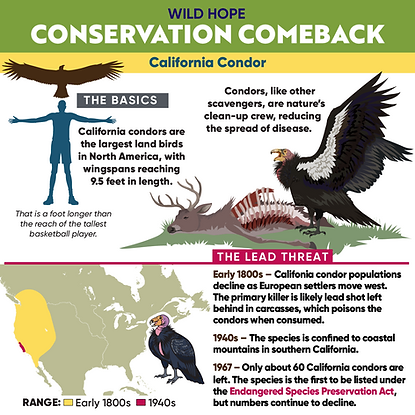Creature
Fast Facts
Introducing you to extinct species.

THE CALIFORNIA
CONDOR LOUSE
1. The California condor louse, Colpocephalum californici, was a parasite that lived exclusively on the California condor. 2. This louse was first described by Roger D. Price and James R. Beer in 1963. 3. The four female and nine male specimens of California condor lice were sent to the Natural History Museum in Washington D.C. 4. There were no signs that this louse harmed its California condor host. 5. Males had two pairs of setae spikes on their heads. Its head was 0.02 inches wide and its thorax was 0.016 inches wide. 6. The females’ first and second segments were longer than the third segment. The tergocentral setae were longer on the second and third segments. 7. In the 1980’s the California condor population was critical. All 27 remaining California condors were brought to the Los Angeles and San Diego Zoo. 8. Those 27 condors were deloused with a pesticide causing a conservation-induced extinction of the California condor louse by 1990. 9. The decision to intentionally cause the extinction of the California condor louse while saving the condor sparked conflicts about how scientists choose which species to save and which to eliminate. 10. Scientists have been studying parasites to help medical advances. Each parasite extinction may eliminate a cure for a human disease. For instance, tapeworms, fleas, and botflies are being studied in the medical world for their abilities to store heavy metals, stop blood clotting, and numb pain.
Extinction
Cometh
Facing the light at the end of the tunnel
EXTINCTION DATE
1990
The California condor louse was first described by Roger D. Price and James R. Beer in 1963, and these 9 holotypes were collected from specimens at the National Zoo in Washington D.C. The holotype was sent to the National Museum of Natural history. These lice did not seem to have a negative impact on their California condor hosts. In the 1980’s the California condor population was critical. All 27 remaining California condors were brought to the Los Angeles and San Diego Zoo as part of a breeding program to save the species. In an act known as “conservation-induced extinction” the zoos chose to use a pesticide to kill all of the remaining lice. By 1990, all of the California condor lice had been eliminated marking its extinction date. This extinction sparked much debate about the need for bio-diversity, and who gets to choose which species to save and which one were worthy of rescue. Although Jurassic Park is fiction, scientists are working on several de-extinction projects. In fact, in 2003 scientists did bring back the extinct Pyrenean ibex, a type of wild goat, for 7 minutes before it died, showing de-extinction is possible. The California condor louse could be a candidate. Scientists would potentially use DNA from one of the nine specimens kept at the Smithsonian Museum. The United States has made many strides in protecting endangered species through many initiatives like the US Endangered Species Act of 1972. Since 1972, many species including the California condor, American bison, bald eagle, black-footed ferret, and grizzly bear have been saved from risk of extinction. If the California condor louse was brought back to life, would people welcome a parasite back to California?
COMING
SOON
The California condor louse's Lazarus Tale has yet to be written. Would it be able to thrive again in California if it did return?
More to Explore
All answers lead to more questions
VIDEOS & ADDITIONAL INFO
Facts about the California Condor Louse
Don't Lose the Louse Research Paper
Article Debating Whether Parasites Should Be Saved
All About Birds - California Condor Facts
Saved! Prehistoric Bird Escapes Extinction - Video
Conservation Comeback - Wild Hope

Examples of the
Colpocephalum genus
Image from iNaturalist UK

Example of the Colpocephalum genus
Image from California Sun


California condor #4 in flight
Image from All About Birds
Californian condor #62 being monitored
Image from All About Birds

Steps that were taken to save the California condor from extinction
Image from Wild Hope

Steps that were taken to save the California condor from extinction
Image from Wild Hope

Steps that were taken to save the California condor from extinction
Image from Wild Hope

The Bakersfield minor league hockey team uses the condor as its mascot
Image from 1000logos.net

"Food Glorious Food!" was the chant of the condors in the Ice Age: The Meltdown movie
Image from Fandom Wiki



